#Ostrog Monastery
Explore tagged Tumblr posts
Text

a personal favorite as well
humans really went off with building on precipitous rock faces
23K notes
·
View notes
Text
Eastern European Escapade Part 5
With the car packed and spirits high, we’re setting off on a new adventure to the captivating land of Montenegro! Nestled along the Adriatic Sea, Montenegro boasts a rich tapestry of history that dates back to ancient times. Once part of the powerful Ottoman Empire and later the Kingdom of Yugoslavia, this small but mighty country has a legacy of diverse cultures and influences.

Montenegro is renowned for its breathtaking beauty, where the Mediterranean flair meets dramatic landscapes. Picture crystal-clear waters lapping against rugged, sunlit coastlines and majestic mountains that seem to touch the sky. From the charming old towns like Kotor, with its medieval architecture, to the stunning Bay of Kotor and the serene beaches of Budva, every corner of Montenegro offers a unique blend of natural splendor and historical charm.


As we drive towards this enchanting destination, we’re filled with excitement for the stunning scenery and magical experiences that await us. Here’s to an unforgettable journey through Montenegro’s wonders!
As we journeyed through Montenegro, each destination unveiled its own slice of paradise. Our adventure began in Budva, where the sun-drenched beaches and vibrant old town set the tone for an unforgettable experience. Wandering through the cobblestone streets, we were charmed by the blend of historical architecture and lively Mediterranean spirit.

Next, we drove to Kotor, a gem nestled between towering mountains and the sparkling Bay of Kotor. The city's medieval walls and narrow alleys, framed by dramatic cliffs, felt like stepping back in time. Climbing the ancient fortifications rewarded us with panoramic views that left us breathless.



Tivat was our next stop, where the luxurious Porto Montenegro marina offered a glimpse into opulent coastal living. We marveled at the sleek yachts and the sophisticated atmosphere, savoring a leisurely stroll along the waterfront.









Ostrog Monastery, perched high in the cliffs of Montenegro's Bjelopavlići plain, is a site of profound historical and spiritual significance. Founded in the 17th century by Vasilije Ostroški, the bishop of Herzegovina, the monastery is dedicated to Saint Basil of Ostrog. It is renowned for its stunning location, built into the sheer rock face, and its status as one of the most important pilgrimage sites in the Orthodox Christian world.

The monastery is divided into two parts: the Upper Monastery and the Lower Monastery. The Upper Monastery, situated at an elevation of about 900 meters, features the church dedicated to Saint Basil, where his relics are enshrined. The Lower Monastery, carved into the rock, is known for its impressive frescoes and serene atmosphere.


Ostrog Monastery has been a beacon of faith and resilience through the centuries, surviving Ottoman invasions and periods of turmoil. Its dramatic setting, combined with its rich history and spiritual significance, makes it a unique and revered landmark in Montenegro.




Our journey took us to the Black Lake in the heart of the mountains, a serene oasis surrounded by lush forests and rugged peaks. The tranquil waters reflected the grandeur of the landscape, providing a perfect retreat into nature.


#makingmyway#floridaboy#travel#gay men#onthego#travel photography#offthebeatenpath#europeanroadtrip#montenegro#tivat#kotor#budva#mediterranean#amazing food#black lake#Ostrog Monastery#beachvibes#beach#adriatic sea#choose your own adventure#adventure#livealifeyoulove
0 notes
Text

ostrog monastery is completely vertical, situated inside of the large ostroška greda rock in montenegro. it's dedicated to saint basil of ostrog and contains his relics, and so is a popular site for pilgrimage. it was built throughout the 17th century and reconstructed in the 20th after a fire.
49 notes
·
View notes
Text
Trip to Trebinje, Mostar, and Ostrog
🏞️📝Activity title: Visiting Trebinje, Mostar, and Ostrog during spring break 🏞️⏱️Duration: 3 days 🏞️❓Type of activity: Activity Activity description My parents and I traveled with my godparents to Trebinje, Mostar, and Ostrog for the christening of their children. We were in Trebinje for a day and then we drove down to the Ostrog Monastery the next day. After that, we traveled to Mostar to rest and see the beautiful city, walk through its busy streets, and eat lunch. Learning outcomes Identify own strengths and develop areas for growth Show commitment to and perseverance in CAS experiences Demonstrate how to initiate and plan a CAS experience Reflection This was a beautiful trip, although I had already previously been to both Trebinje and Mostar. However, before this trip I had never been to Ostrog. It was a beautiful sight to see and experience. My godparents are great and they were very fun to be around. Their two little girls are precious and I had fun spending time with them. We are hoping to travel together again at some point.









4 notes
·
View notes
Text
Saints&Reading: Thursday, August 24, 2023
august 11_august 24
VENERABLE THEODOSIUS, (FEDOR) PRINCE OF OSTROZH (1483)

Saint Theodore, Prince of Ostrog, gained fame with the construction of churches and by his defense of Orthodoxy in Volhynia against the enroachment of Papism. He was descended from Saint Vladimir (July 15), through a great-grandson Svyatopolk-Michael, prince of Turov (1080-1093) and later Great Prince of Kiev (+1113).
The first time the name of the holy Prince Theodore is mentioned is in the year 1386, when the Polish king Jagiello and the Lithuanian prince Vitovt affirmed his hereditary possession of the Ostrog district, and they augmented the Zaslavsk and Koretsk surroundings.
In 1410 Saint Theodore participated in the defeat of the Teutonic Knights of the Catholic Order at the Battle of Gruenwald. In 1422 the holy prince, because of sympathy for the Orthodox in Bohemia, supported the Hussites in their struggle with the German emperor Sigismund. Theodore introduced the Hussite formation (i.e., the Taborite, adopted by the Ukrainian Cossacks) into Russian military strategy.
In 1432, after winning a series of victories over the Polish forces, Saint Theodore compelled Prince Jagiello to guarantee the freedom of Orthodoxy in Volhynia under the law. Prince Svidrigailo, apprehensive of the strengthening of his ally, locked Saint Theodore into prison, but the people who loved the saint rose up in rebellion, and he was freed.
Saint Theodore was reconciled with the offender and went to him for help in the struggle against the Lithuanians and the Poles. In 1438, the holy prince took part in a battle with the Tatars. In 1440, with the accession to the Polish throne of Cazimir, youngest son of Prince Jagiello, Saint Theodore received the rights of administration of the city of Vladimir, Dubno, Ostrog, and he was granted extensive holdings in the best regions of Podolia and Volhynia.
Saint Theodore left all this behind, together with princely power and fame. After 1441 he entered the Kiev Caves monastery, where he received the monastic tonsure with the name Theodosius, he struggled there for the salvation of his soul until the time of his blessed repose.
The year of Saint Theodore’s death is unknown, but it is probable that he died in the second half of the fifteenth century at a great old age (S. M. Soloviev in his History of Russia gives the year of his death as 1483). The saint was buried in the Far Caves of Saint Theodosius. His glorification apparently took place at the end of the sixteenth century, since in the year 1638 the hieromonk Athanasius Kal’nophysky testified that “Saint Theodore rests in the Theodosiev Cave, where his body was discovered incorrupt.”
Saint Theodore is also commemorated on the Synaxis of the Monastic Fathers of the Far Caves on August 28.
SAINT NYPHONTES, PATRIARCH OF CONSTANTINOPLE (1483)

Saint Nḗphon II, the Patriarch of Constantinople, was from the Peloponnesos. His parents were named Manuel and Maria, and he was named Nicholas in Holy Baptism. Later, he was tonsured as a monk at Epidauros, receiving the new name Nḗphon.
After the death of his Elder Anthony, he went to Mount Athos, where he occupied himself by copying books. Afterward, he was chosen as Metropolitan of Thessaloniki. In 1486 he occupied the Patriarchal throne of Constantinople.
Banished in 1488, the Saint went to the Holy Mountain, at first to Vatopedi Monastery, and then to the monastery of Saint John the Forerunner (Dionysiou). He concealed his rank and occupied the lowliest position. By God’s providence, his rank was revealed to the brethren of the monastery. Once, when the Saint was returning from the forest where he had gone for firewood, all the brethren went out to meet him, greeting him as Patriarch. But even after this, the Saint continued to share various tasks with the brethren.
In all, he served three times as Patriarch of Constantinople: 1486-1488; 1497-1498; and 1502.
Saint Nḗphon reposed on September 3, 1508 at the age of 90. Immediately after his death, he was honored as a Saint in many places. On August 16, 1517, in the newly-established monastery of Curtea de Argeş, Patriarch Theoleptos of Constantinople, together with the Synod of the Romanian Lands, and the Igoumens of the Athonite monasteries, performed the solemn glorification of Saint Nḗphon, decreeing that his Feast Day be celebrated on August 11th.
His relics are kept in a shrine at the Monastery of Dionysiou, where there is also a chapel dedicated to him. In gratitude, the Athonite monks gave the Saint's head and hand to Nyagoe Basarab, who placed them in the Monastery he built at Curtea de Argeş in what is now Romania. In the XVIII century, these relics were placed in a silver reliquary.
At the behest of the Holy Synod of the Romanian Orthodox Church, they were brought to Craiova, to the church of Saint Dēmḗtrios, the Metropolitan cathedral of Oltenia on October 25, 1949.
In 2009, the relics of Saint Nḗphon were moved to the Cathedral of the Ascension of the Lord at Târgovişte.
Source: All texts Orthodox Church in America_ OCA
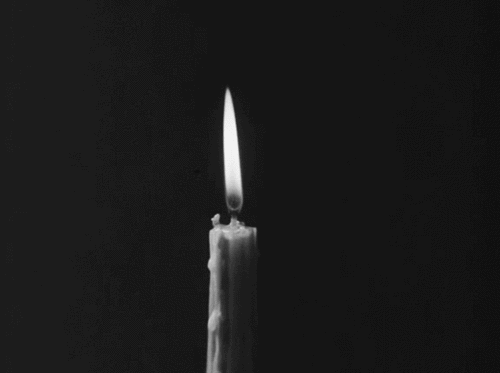
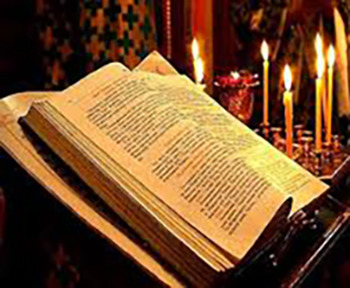
2 CORINTHIANS 7:1-10
1 Therefore, having these promises, beloved, let us cleanse ourselves from all filthiness of the flesh and spirit, perfecting holiness in the fear of God. 2 Open your hearts to us. We have wronged no one, we have corrupted no one, we have cheated no one. 3 do not say this to condemn; for I have said before that you are in our hearts, to die together and to live together. 4 Great is my boldness of speech toward you, great is my boasting on your behalf. I am filled with comfort. I am exceedingly joyful in all our tribulation. 5 For indeed, when we came to Macedonia, our bodies had no rest, but we were troubled on every side. Outside were conflicts, inside were fears. 6 Nevertheless God, who comforts the downcast, comforted us by the coming of Titus, 7 and not only by his coming, but also by the consolation with which he was comforted in you, when he told us of your earnest desire, your mourning, your zeal for me, so that I rejoiced even more. 8 For even if I made you sorry with my letter, I do not regret it; though I did regret it. For I perceive that the same epistle made you sorry, though only for a while 9 Now I rejoice, not that you were made sorry, but that your sorrow led to repentance. For you were made sorry in a godly manner, that you might suffer loss from us in nothing. 10 For godly sorrow produces repentance leading to salvation, not to be regretted; but the sorrow of the world produces death.
MARK 1:29-35
29 Now as soon as they had come out of the synagogue, they entered the house of Simon and Andrew, with James and John. 30 But Simon's wife's mother lay sick with a fever, and they told Him about her at once. 31 So He came and took her by the hand and lifted her up, and immediately the fever left her. And she served them. 32 At evening, when the sun had set, they brought to Him all who were sick and those who were demon-possessed. 33 And the whole city was gathered together at the door. 34 Then He healed many who were sick with various diseases, and cast out many demons; and He did not allow the demons to speak, because they knew Him. 35 Now in the morning, having risen a long while before daylight, He went out and departed to a solitary place; and there He prayed.
#orthodoxy#orthodoxchristianity#easternorthodoxchurch#originofchristianity#spirituality#holyscriptures#gospel#bible#wisdom#saints
6 notes
·
View notes
Text
Upload: [7 Days Random Countries Architecture] Germany, Brunei, Argentina, Lesotho, Grenada, Belarus, Montenegro.







Germany: It's been a long time since I've been here. I decided from today to make myself a 7 day challenge, where I have to make a quick sketch architecture of a random country and place, I got Germany and using google maps, I decided to poke at a random place in the country and got a castle Wartburg, the courtyard if I'm not mistaken. I rarely draw architecture, but these days I want to get my hand into sketching architecture.
Brunei: Yes, I'm continuing my 2nd day of drawing architecture and I was randomly assigned to this country, I was looking for something to draw in it and came across Jame' Asr Hassanil Bolkiah Mosque, a very beautiful architectural building, and quite happy with these sketches, even though they just turned out.
Argentina: So I continue 3 day drawing architecture and my turn was Argentina, I came across the Teatro Colón, it was difficult for my brain to do sketches, below is my attempt to take a piece of the theater, the feeling is not strongly conveyed, but I liked my shading of the column part of this architecture, further such shading decided to add a little to the main sketch above, I want to visit Argentina and especially in this theater!
Lesotho: So, continuing with the 4th day of sketching architecture, I came across this country Lesotho, an African country with beautiful mountains, found a building called "The Basotho Craft Center" looks cool and I decided to sketch it.
Grenada: So, day 5 doing a sketch and I came across Grenada, I stumbled upon the Cathedral of the Immaculate Conception and began to do its sketch, long searched for what to draw there, it was quite difficult to look on google maps, but found it and quite satisfied.
Belarus: Well, here's day 6 sketches, this time I got Belarus, Mir Castle, one of the interesting Gothic Belarusian architectural heritage, I was very interested in it and tried to pass it, but the bold liner and the peculiar shadows that marked the castle outside and something to give, but I got carried away with them strongly. It's a beautiful castle, I'll think about doing it again in a year.
Montenegro: Day 7 of sketching architecture and I got Montenegro. How I dreamed of seeing it here and it fell to me, I was happy about it, I looked for sights and chose Ostrog, it is a monastery in Montenegro, which is located directly in the mountain, I was interested in it and I wanted to do, I hope to go there and see Montenegro.
#architecture#sketch#traditional art#country#belarus#germany#montenegro#brunei#argentina#lesotho#challenge#line art#brushpen#grenada
4 notes
·
View notes
Text

The monasteries on the islets of Sveti Dorde and Our Lady of the Rocks are visible off the coast of Perast, Montenegro. More than 50 monasteries across the small nation are open to the public. Photograph By Kurt Henseler, Laif/Redux
How To Plan Your Pilgrimage To Montenegro‘s Sacred Spaces
Off the beaten path, these monasteries offer a more contemplative way to explore the Mediterranean country’s stunning coastlines, rugged mountains, and turquoise lakes.
— By Kimberley J. Graham | Apri 5, 2023
A country the size of Connecticut, Montenegro has been at the crossroads of East and West for centuries. Its distinct spiritual heritage draws thousands of pilgrims.
Many of Montenegro’s one thousand Christian and Muslim religious sites have long been abandoned due to due to conflicts from World War I to the Balkan wars. But more than 50 of its Christian monasteries remain active and open to the public. Some have experienced a renaissance in recent decades with young monastic communities revitalizing neglected sites; others persist due to the dedication of a sole resident monk.
Set against backdrops of turquoise lakes, dramatic coastlines, and rugged mountains, Montenegrin monasteries offer travelers glimpses into a different era. They showcase elaborate frescos and architectural styles from Byzantine to Ottoman. Here’s how to experience a few of them.

A Land of War
“Montenegro has a very interesting cultural heritage that is not found in any other country in Europe,” says Adnan Prekić, a history professor at the University of Montenegro.
By 100 B.C. the Roman Empire had fully absorbed the Balkans, including present-day Montenegro, into its provinces. In A.D. 395, Montenegro was the dividing line between the Catholic-centric west and the Eastern Orthodoxy of the Byzantine Empire in the east. With the arrival of the Slovenes in the seventh century, Eastern Orthodoxy quickly dominated the region.
After Montenegro freed itself from the Serbian Empire in 1455, it became one of the last free states in the Balkans. But the following centuries saw occupations by the Venetians and the Ottomans, who brought Islam to the region. This all affected the region’s architecture and history.
Ostrog Monastery
Established in the 17th century as a place of refuge from the Ottomans, the Ostrog monastery is an architectural feat. Carved into the cliff face of Ostroška Greda, near the tiny village of Dabojevići, the structure’s stark-white exterior bear gold-leafed frescos, a stark contrast with the stone mountain.

Constructed in 1665 within two large caves on the rock face of Ostroška Greda in Montenegro, Ostrog monestary seems to defy gravity. It is dedicated to St. Vasilije of Ostrog, who is buried inside. Photograph By Clemens Zahn, Laif/Redux
The monastery has two sections connected by a steep forested path. The lower portion houses the Holy Trinity Church, where visitors can admire vibrant frescos.
Each year thousands of pilgrims crawl or walk barefoot up the path to the upper Ostrog monastery, where they pray in front of the remains of St. Vasilije (1610-1671), known locally as “miracle worker.” The saint’s body is guarded by a priest and covered with an embroidered blanket.
“People believe if you go to the Ostrog monastery and you pray in front of the body of St. Vasilije that your wishes will be heard and that your diseases can be [cured],” says Marianne van Twillert, author of Montenegro off the Beaten Track—21 Adventurous Road Tours. “This is very popular, not only with the local population, but with the Muslim and Catholic people. They all believe in the miracles of St. Vasilije.”
Every May 12, pilgrims commemorate his death by embarking on a 25-mile pilgrimage from the capital city of Podgorica to Ostrog.
Beška Monastery
More than two dozen medieval abbeys dotted the islands in Lake Skadar during the Balšić Dynasty in the 14th and 15th centuries. The region was strongly influenced by Greek monks from Mount Athos, an Orthodox spiritual center. The abbeys thrived until the 19th century when occupying Turks destroyed most of them, but around 10 of the Orthodox sites remain.
Visitors can explore this history at the Beška monastery, located on a small isle on the lake’s western shore. The sanctuary was abandoned for nearly 400 years, but a decade ago, a group of nuns started bringing it back to life. It holds two churches, including St. Mary’s Church, with traces of Greek, Byzantine, and Slavic frescoes.


Left: After being abandoned for nearly 400 years, Beška monastery, located on an island with the same name in Lake Skadar, was revived by a community of nuns. Photograph By Georg Knoll, Laif/Redux Right: Religious objects used during rituals like Holy Communion are stored in this room at Our Lady of the Rock Church in Perast, Montenegro. Photograph By Panther Media GMBH, Alamy Stock Photo
The nuns are also reviving arts such as icon making, where religious images are painted on wooden panels. These devotional objects are sold to visitors to support the site’s upkeep.
Church of Our Lady of the Rocks
Hundreds of tourists venture to the Venetian city of Perast to see the small blue-domed church floating in the Bay of Kotor.
According to local lore, in 1452 two brothers (one suffering from a leg injury) spotted an icon of the Madonna and Child here on a rock protruding out of the sea. They took the stone home and went to sleep. In the morning, the icon was gone and the brother’s leg was healed. Believing it was a divine message, locals erected a shrine to the Madonna, stacking rocks to form a small island where the icon was found.
Thirty-two years after the brothers discovered the icon, the town built an Orthodox church on the island. In 1630, the Roman Catholic Church claimed the site and built a new chapel in place of the original.

A manmade island in the Bay of Kotor near the city of Perast holds the historic Church of Our Lady of the Rocks. Photograph By GHI, Education Images/Universal Images Group/Getty Images
Today, that Church of Our Lady of the Rocks features more than 2,500 silver plaques donated by sailors who credited their safe return from the sea to the Madonna’s protection. Its walls and the ceilings also hold 68 frescoes by Tripo Kokolja, a famed Baroque artist and native of Perast.
An adjacent museum houses Illyrian artifacts found nearby, paintings of local ships, and a tapestry, “Love and Faith,” woven by local artist Jacinta Kunić-Mijović. Crafted over 25 years while she waited for her sailor husband to return from voyages, it depicts the Madonna and child in silk, silver and gold threads, and the artist’s own hair.
Each July 22 since 1938, the city has celebrated Fašinada to mark the brothers discovery of the icon. Residents decorate boats with ribbons and flowers, then fill them with rocks and sink them around the island.
— WHAT TO KNOW:
Beška Monastery: Private boat tours depart from Virpazar, a 30-minute drive from the capital Podgorica.
Ostrog Monastery: It’s customary to bring a donation, like soap or blankets, for the monks and leave it in the baskets outside the entrance to the shrine.
Church of Our Lady of the Rocks: Boats depart from Perast or Kotor. There is a dollar entrance fee for the museum.
Modest clothes that cover shoulders and knees are required when visiting the Monasteries.
0 notes
Photo



Ostrog Monastery, Montenegro
#montenegro#monastery#ostrog#ostrog monastery#europe#travel#travel blog#vertical#architecture#view#balkans#orthodox church
3K notes
·
View notes
Photo










ostrog monastery
#ostrog#bosnia#bosnien#bośnia#monastery#ostrog monastery#mountains#nature#35mm#onfilm#ishootfilm#filmisnotdead#filmisalive#film photography#analogue#analog#smena#smena8m#smena 8m#thefilmcollective#thefilmcommunity#theanalogueproject#vintage#retro
65 notes
·
View notes
Text
Temples and monasteries of Montenegro - 20 main shrines
New Post has been published on https://tripsterguru.com/temples-and-monasteries-of-montenegro-20-main-shrines/
Temples and monasteries of Montenegro - 20 main shrines

Crystal clear Adriatic Sea, mountain landscape, picturesque valleys, comfortable climate make holidays in Montenegro popular for people of any age. There are no communication problems (minimal language barrier), the infrastructure of the resorts is well organized (relaxation is possible at any time of the year), and a huge number of architectural sights of the country are available for viewing. Among them, in the first place are the famous temples and monasteries of Montenegro, hidden in the thickets of luxurious greenery of rare plants, shrouded in an atmosphere of ancient legends, secrets of Montenegro.
Ostrog Monastery
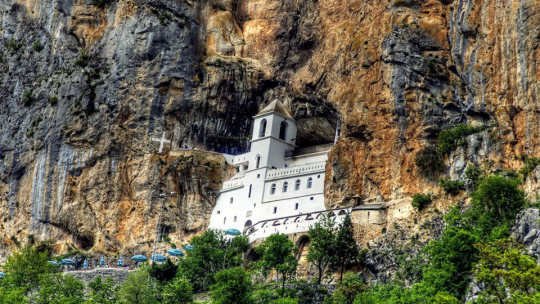
An endless stream of tourists, pilgrims go to the main attractions of Montenegro. The cloister of the miracle worker Vasily Ostrozhsky is hidden in a rock at an altitude of 900 m above sea level (his relics are the greatest shrine in the world of the Orthodox Church). It has long been a haven for people who believe in help, the fulfillment of the most secret desires of the miraculous power of the Holy.
In a place filled with prayers of a special energy (next to the holy source, miraculous relics), they find help in solving problems, troubles. A sacred place appeared in the middle of the XVII century. The prison consists of two parts: the upper (older) and lower parts, created in the XIX century. In the lower zone is the church of the Holy Trinity with the relics of a 12 year old boy – the martyr Stanko.
The parts are divided by a steep path, about 5 km long, and you can overcome the distance (going uphill) along a special path in 30 minutes. Before the appearance of Vasily Ostrozhsky, hermit monks lived here in a cave hidden from the eyes of people. Gradually, two churches appeared in the sacred place: Holy Cross Exaltation, Vvedensky (Introduction of the Blessed Virgin Mary). In the last place, the Great Miracle Worker, who died in 1671, prayed. His relics (in the role of the main shrine of Ostrog) are stored in a small cave of the Vvedensky church.
Cetinje Monastery

The architectural, historical ensemble of Montenegro is the political, cultural center of the country. Here, on the site of the Zeta (the ancient South Slavic princedom that existed on the site of modern Montenegro), a monastery was built in 1484, which existed until the Turks destroyed it in 1692. The new building was destroyed several times, restored and was the residence of the Metropolitan of Montenegro in its ancient capital – the city of Cetinje, located at the foot of Mount Eagle Cross.
In the Middle Ages, buildings served as a powerful fortress. She was surrounded by a moat with water and stakes, fortified by loopholes. Now you can see part of the brick walls of the fortress. On the historical territory are the Palace-Museum of King Nikola, the Church of the Nativity of the Blessed Virgin Mary.
Here are the remains of the king and his wife Milena, gifts from the emperors of Russia, a valuable collection of prints from the 13-19 centuries. The first printing house of Montenegro worked here. The first high school of the country opened in 1880 within the walls of the building. The famous works of the “Oktoih Pyatoglasnik”, “Psalter”, “Prayer Book”, “Four Gospels” are among the protected shrines. Keeps one of the richest collections of shrines of the Orthodox Church.
Moraca Monastery

One of the main Orthodox monuments of the Middle Ages in the Balkans is an architectural complex consisting of the building of the Cathedral of the Assumption of Our Lady, a small church in honor of St. Nicholas and living quarters for monks. It is located along the right bank of the Moraca Canyon in a beautiful mountainous area. All tourist routes try to include in their programs a visit to this unusual place.
The magnificent building with one nave, a cylinder-shaped soda was erected in 1252 from soft tuff covered with plaster. Of the many frescoes (the 13th-century technique of mural painting has no analogues in beauty), created under the direction of Stevan (the son of the Serbian king). His grave is on a local graveyard.
Now 11 scenes related to the life of the prophet Elijah have been preserved from the interior. The main work on the restoration of the destroyed architectural treasures was carried out in the XVIII century by the artists of Montenegro. The exact time of the construction of the small church of St. Nicholas is not precisely determined: the monks consider it to be a more ancient structure than the cathedral. Of interest is the interior decoration made by ancient murals from frescoes.
Piva Monastery
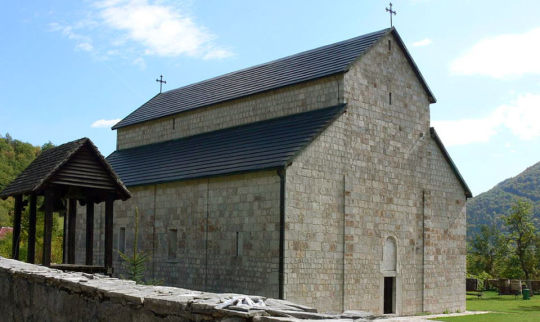
Among the 1600 church sights of the country there are large, small, included in tourist routes, almost forgotten. You are invited to see them on your own or with local excursions. Such a building, called the symbol of invincibility of the inhabitants of the country, is located near Pluzine in the northern part of Montenegro. Among the pine forests near the “Pivsky Oka” in the XVI century there appeared an ordinary house with narrow loopholes that did not attract the attention of the Turks.
Later (after the construction of the hydroelectric power station on the Piva River) the building was moved 2 km higher. In its former place, a guest house (konak), a bakery, a cemetery have been preserved. Here they helped the rebels, sheltered the rebels, held negotiations with representatives of the Christian world. The building is built of stones of gray, pink shades. It has large dimensions: height 13m, length 23, width 15m. The appearance of the building did not cause enemies to rob him.
Inside, there are many old frescoes, a gold-plated iconostasis with a huge cross. A large number of manuscripts, paintings, books, and jewelry are also stored here. One monk lives here permanently. He keeps order, manages the bells, which are not on the roof of the main building, but under the roof of a separate annex. Come to the center of the spiritual life of Herzegovina (now the existing monastery is owned by the Serbian diocese) is proposed by boat on Lake Piva.
Church of the Resurrection of Christ in Podgorica
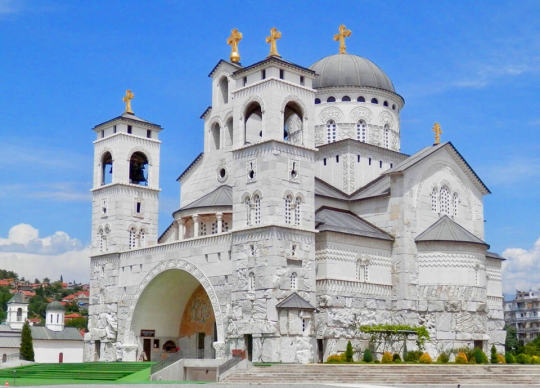
For a long time in the country there was no main church of the Orthodox Church. Since 1993, the first stone was laid in the future huge building, striking in size, splendor of decoration, design. The construction began in the presence of Patriarch Alexy II. The author of the project was architect Pedja Ristic. The building belongs to the Neo-Byzantine style. It included many new architectural elements. The height of the two levels of the cathedral is 41.5 m, the belfry is made of 17 bells (2 brought from Voronezh), 7 crosses sparkling with gilding.
The monumental view of the building is formed by huge blocks of stone, decorated with antique. The interior is characterized by an abundance of images made of small pieces of granite, marble. Mosaic “Noah’s Ark”, a fresco above the entrance measuring 53.5 m 2. In one of the largest temples in Europe at the same time accommodates up to 5 thousand believers.
Daibabe Monastery in Podgorica

At a distance of 4 km from the capital of Montenegro is an amazing place hidden in rocky caves. You can find it by a small building dedicated to the Assumption of the Blessed Virgin Mary with belfries on the sides. The main premises are underground in caves located in the shape of a cross. Local legends say that as early as the III century, the first Christians were hiding in catacombs with their own source of water. The monastery appeared in 1897 and its first rector was the miracle worker Simeon of Daibab (his relics are stored here).
The first liturgy was performed in the cave church in January 1897. The dimensions of the cave used are 20 m in length and about 3 m in width. Chapels are hollowed out on the side walls; an altar is located in the center. The ceiling, the walls were painted by Simeon, his followers. The surviving murals are of great value. In an atmosphere of silence, peace, numerous pilgrims receive relief, hope for a favorable solution to their problems.
Cathedral of St. Tryphon in Kotor
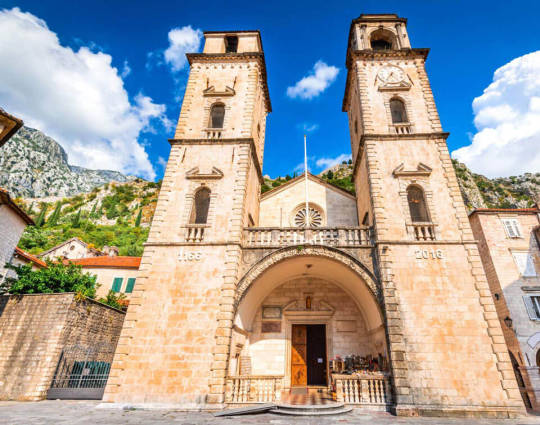
The ancient building is depicted on the coat of arms of the city of Kotor. Saint Tryphon, repeating the path of Jesus Christ, is considered the patron saint of the city. The cathedral in his honor was laid in 1166. Previously, this place was a church, built in 809 by the noble townsman Andrii Saracenis. It was he who bought the relics of St. Tryphon au merchants of Venice.
The devastating earthquake of 1667 required the rebuilding of the bell tower of the cathedral. They are made in the form of high towers (up to 35 m high) made of special stone brought from the island of Korcula. Above the entrance is a window in the shape of the famous “outlet”. The ancient frescoes of the interior are poorly preserved. But even now, under centuries-old layers of stucco, lime on the apse, nave arches fragments of Byzantine-style paintings are revealed.
The exact time, the author of their writing remains the secret of the cathedral. The origin of the rare wooden crucifix in the church is also unknown. The relics of St. Tryphon are considered the main shrine of the Cathedral. In the sarcophagus, standing to the right of the entrance, lies the body of Andria Saracenis. The Cathedral, as a preserved example of the style of Romanesque architecture, is a World Heritage Site.
Church of St. Luke in Kotor
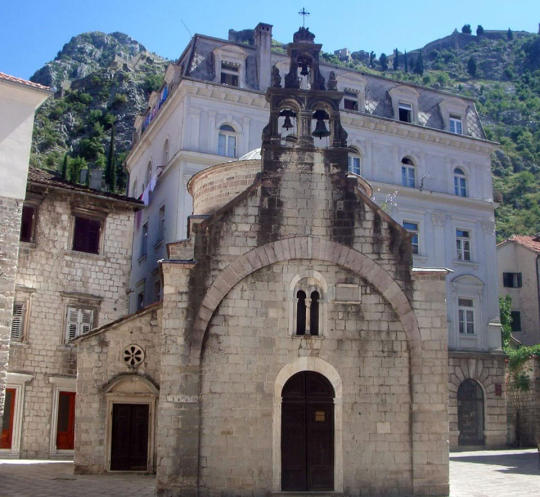
A modest, not conspicuous temple, standing in the historical part of Kotor, is in fact a famous landmark and the oldest church in Montenegro. It was built in 1195 at the expense of the rich feudal lord Kazafragi (a memorial inscription testifies to this). In the current church there are two altars: Catholic and Orthodox), which is rarely found in temples of the world. The two branches of the Christian religion lived here peacefully, in harmony. The main shrines of the cathedral are particles of the relics of St. Luke, the martyrs of Orestes, Mardarius, Auxentius.
Among the interior, fragments of ancient frescoes by Italian, Cretan masters of the 17th and 18th centuries have been preserved. In a small chapel owned by the church, there is a unique iconostasis depicting Christ in the image of the King. The temple opens on holidays, before the planned excursions, weddings, baptisms. An interesting fact is the burial of local residents inside the building. Its entire floor consists of grave gravestones. During the great earthquake of 1979, this church was the only building that was not damaged.
Church of St. Nicholas in Kotor

On Grets Square in the old center of Kotor rises a relatively young Cathedral building, erected in honor of the patron saint of travelers, sailors St. Nicholas. Historically, the existence of a Dominican monastery in this place, turned into a soldier’s barracks for Napoleon’s army, is historically confirmed. After the destruction of the church was built here, life, which broke off the fire of 1896. A new temple was erected on its foundation in 1909.
The building is in line with the pseudo – Byzantine architectural style. At the entrance are two tall belfries. Among the interior decoration stands the iconostasis of three meters high, created in 1908 by Czech artist Ziegler. The treasury of a beautiful building contains many valuable documents, icons, art objects, clothes. The most interesting are the Three-Handed icon, the book “The Sacrifice of Abraham of 1899”, the image of Nicholas the Wonderworker in the form of a mosaic at the entrance. In the courtyard you can use a source of healing water. Services are held daily.
Church on the Island of the Virgin

The history of the creation of the ancient church on the reef, which turned into an island in the original construction way, annually attracts many tourists to the city of Perast. Virgin Mary, living on a reef, protects the local sailors. As a token of gratitude, the locals regularly spend here a feast of fashinada. On decorated boats, they swim around the island three times and throw stones into the water, strengthening the shore.
In such a strange construction way, for almost two centuries, stones were collected on the sunken ships, reefs, a stable platform was formed. It grew an ancient landmark of the country church. The ground floor of the building is decorated with icons, paintings of artists of the 17th century, an organ sounds, whose age is 300 years. The altar is made of four types of valuable snow-white marble and is decorated with the image of the face of the Holy Virgin. It illuminates the interior of the chandelier made of real Murano glass, made almost 3 centuries ago. The archaeological museum is invited to see old exhibits: Roman crosses, a fountain, silver roots.
Drimsim is the first universal sim card for travelers. Internet abroad starts at $ 1 per megabyte, and calls start at $ 3 per minute. Works in 197 countries! Lifting mechanisms, lights, bells and other elements belonging to ships of different countries at many times. On the second floor are amazing ancient amphoras, jugs, mysterious captain’s chests. A collection of paintings depicting ships, the olive stele of Diva, adorning the bow of a ship in the Middle Ages. Among them is a unique icon of the Holy Virgin, embroidered by a woman from Perast, who had been waiting for 25 years for the return of her sailor husband. Thousands of plates (gold, silver, bronze) are mounted in the walls of the building. They were presented by sailors (the custom still exists) in gratitude to the Virgin for a successful voyage.
Cathedral Church in Bar

A magnificent building was built on the site of the construction of the XVI century in 1863. The last reconstruction was carried out in 2016. The cathedral was consecrated in the name of the first ruler of Montenegro, Jovan Vladimir, who accepted the death of a martyr on the cross. The snow-white architectural creation is decorated with three golden, sparkling domes. They are trophies taken during the Austro-Hungarian occupation in 1918. All bells, guns, cores were remelted and new ones were made. For the past few decades, the cathedral has been the main Orthodox church in the city.
For the manufacture of walls, a beautiful-looking solid stone (red limestone) was used. On the facade there is a window in the form of a “rose outlet”. Inside the cathedral, frescoes with images of Saints have been preserved. The cathedral church is called the largest religious building in Montenegro. Its height is 41 m, an area of 1200 m2. Services are held daily. In a special room of the amphitheater, events are held for cultural and spiritual development of the population.
Gradiste Monastery

In 1116, the construction of Hradiste began on the site of ancient buildings (Grajevine) and the old Greco-Roman cemetery. It became a monument of fresco painting of the Middle Ages in Montenegro. The surviving ensemble includes a cell building, the ruins of a protective wall, a cemetery, and the structures of three churches.
Among them:
Saint Sava. One-nave building of alternating rows of white, red stone and a belfry with three bells. The iconostasis was painted by Nicholas Aspiotis in 1864.
St. Nicholas. Built in the XII century, painted by a fresco master from Budimlya. Among his creations is the fresco “Mammal” (patroness of young mothers). In antiquity, mother’s gifts that did not have breast milk were left next to her. A luxurious carved iconostasis appeared here in 1796.
Assumption of the Blessed Virgin Mary. The small building is located on the upper platform next to the cemetery. The frescoes depict saints from the Nemanich family.
The buildings suffered greatly from destruction during the invasion of the Tatars, the French, during the war of 1941, from a severe earthquake.
Podmaine Monastery in Budva

Historical facts indicate the emergence of a Christian structure at the foot of Mount Ostrog or in a place called Maina, around the time of the reign of the Nemanichi dynasty. For a long period of time here was the residence of the country’s metropolitans. Within its walls, Negosh wrote a literary work, “The Crown of the Mountains,” which became the literary monument of Montenegro. The buildings were given a new life by the modern restoration and opening of the complex in 1995. The complex includes two churches dedicated to the Assumption of the Blessed Virgin Mary.
The large building was renovated in 2000. The icon painter again portrayed the scenes of the Last Judgment, placing among the sinners the image of the communist leader Broz Tito of Yugoslavia. The small church (4 m long and 2.5 m wide) is a catacomb of the first Christians and is located under cells. The building was built in the XII century. A stone water tank is installed in the center. She is famous for amazing stone carving. There is an inscription in the room, indicating that the last restoration took place in 1630.
Dulevo Monastery
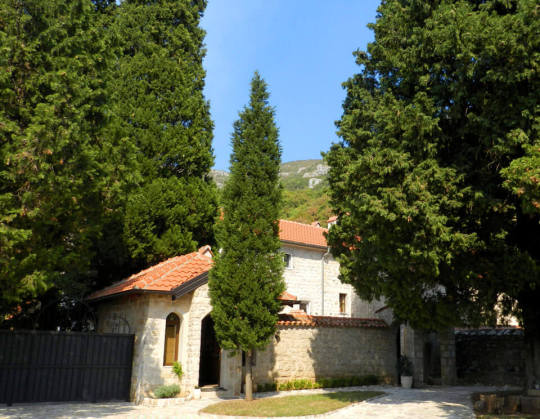
There is a written mention of the structure that appeared in honor of the soldiers of King Dushan in the middle of the XVI century. The novices of the Decana parish came here after a haircut. The building was often destroyed by wars, natural disasters. Now it is fully restored. On the walls of the south and north sides are visible traces of former buildings, a cell building with narrow windows in the form of loopholes, a belfry with a bell. Inside the old building, fragments of two layers of ancient painting, the original frescoes, have been preserved.
They depict scenes from the lives of saints and are a matter of pride. The vault of the room is decorated with compositions covering important gospel events: the Present, Christmas, and the Crucifixion. On it are six medallions depicting Christ, Our Lady of Oranta, and saints. Two cells are located in the upper part of the building (Saint Sava worked in them before traveling to the Holy Mountain).
On the territory there is a source (Savvina Voda), which helps pilgrims treat diseases of the stomach. According to legend, the soldiers of King Dushan were healed of typhoid fever by this water. It is also proposed to see an old oak tree under which Saint Sava sat. The complex is located on a plateau above St. Stephen.
Praskvitsa Monastery
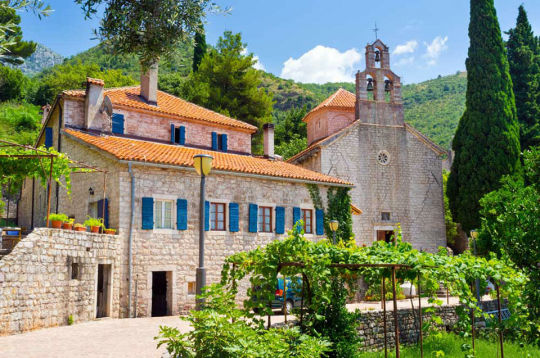
High in the mountains, near the villages of St. Stephen and Pržno, not far from a stream that smells of peaches (where the name of the building came from), an ancient monastic monastery lurks. The religious shrine of Montenegro appeared in 1059. After severe destruction, a new stage in her life began in 1844. The new church of St. Nicholas (the original construction was carried out in 1413), together with the Holy Trinity Church and monastery cells, are included in the architectural ensemble, which is a landmark of the country.
Along with the tour, you can sit at a stone table where the council of elders made crucial decisions of the Middle Ages. Visit the museum with a treasury. It contains a valuable collection of icons, ancient artworks, ancient weapons. Manuscript books (among them the Gospel of the 16th century), documents of the Pashtrovich era, an old monastery seal, the golden cross of Dushan. In the cells there is a valuable library with a total number of books over 5,000 copies.
Rustovo Monastery
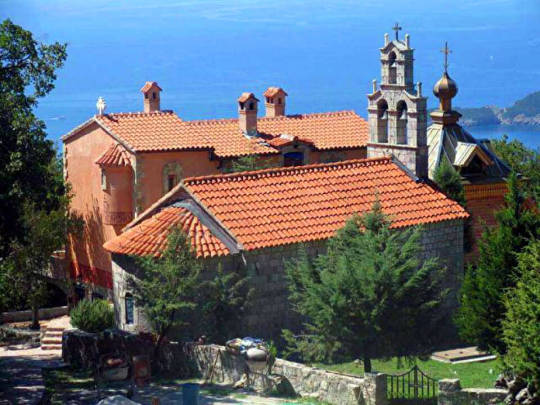
In the current monastery for nuns live 8 sisters. They serve the buildings included in the monastery ensemble. Today it includes the construction of three temples. In 2003, a monastery was founded on the site of the ancient church of the Assumption of the Blessed Virgin Mary (built in the XIV century, destroyed by fires, an earthquake). His consecration took place on the Epiphany Eve. You can still consider the preserved foundation of the ancient structure.
During the construction process, the remains of the pastoral martyrs of the XIV century were found. Archbishop Amphilochius laid the foundation in 20005 for a small cathedral dedicated to members of the Romanov family who were martyred. The remains of the XIV century sufferers were first placed under the altar of a large church, and then buried in the foundation of the Romanov temple.
The third temple (paraclis) is located in the cell building. It is dedicated to the famous saint of the VI century, who founded a large number of temples. Located next to Chelobrodo Hill. It offers a panorama of the most beautiful part of the Adriatic Sea of Montenegro.
Church of the Archangel Michael in Herceg Novi
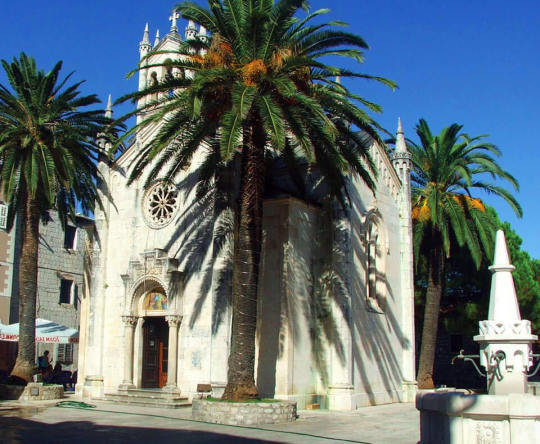
The Orthodox Church, whose age is just over 100 years old, is considered the pearl of the Montenegro region. It stands in the center of the old quarter, on the Stefan Vukmcha square in Herceg Novi. The unusual architectural style is associated with the participation of several architects in its construction. Each of them expressed his preference for the Romanesque, Byzantine, Gothic, Baroque, Islamic architectural heritage. All elements blend in harmoniously and form a unique appearance of the structure.
The interior is striking in its exquisite beauty. The altar and iconostasis were made by master Bilinich from beautiful, rare marble. Many icons are considered rare, unique. They are written by Czech artist Ziegler. The local library holds a large number of church books, including from Russia. The building is surrounded by majestic palm trees. On the beautiful square there are many cozy cafes, places for relaxation, viewing the temple.
Church of the Savior in Herceg Novi

Behind a high stone fence on the main street (Negosheva) is an old temple complex consisting of the churches of the Savior and St. George. The first was built in 1713 from stone blocks brought from the island of Croatia. It received its final appearance in 1864 as a result of a complete restructuring, starting with the foundation. In the middle of the next century, an interesting iconostasis appeared in the building, a belfry with three bells.
Among the many decorations of the interior are several Russian icons. The Church of St. George was built at the end of the 17th century. This place used to be a Turkish mosque. The main shrine is a round icon depicting Saints Peter and Paul. The archives store old books, icons, church dishes made of silver. Behind the fence is an old cemetery, a two-story building of the residence of the bishops of 1700, a school where the future famous poet and priest of Montenegro Negosh studied.
Savina Monastery

The current complex (10 monks live in it), surrounded by a garden with many exotic plants, is the center of Orthodoxy among the settlements along the Boka Kotorska Bay. It is named after the first archbishop of Serbia, St. Sava. The complex includes three buildings: Malaya Uspenskaya, Bolshaya Uspenskaya and St. Sava Church (it is located next to the upper cemetery). The Small Cathedral (10 m long and about 6 m wide) was built in 1039.
The main preserved value is the ancient frescoes made in the Byzantine, Gothic styles. At the end of the 18th century, under the leadership of the Venetian architect Nikola Foretic, the Great Temple was built in the style of luxurious baroque. The iconostasis of the 18th century, consisting of separate zones created in the traditions of the Orthodox style of the east, has been preserved.
Sacred relics are considered to be a crystal cross belonging to Savva and decorated with rubies, the relics of Tsarina Helena, George the Victorious, the shroud of 1642. Icon collection, library containing over 5,000 rare manuscripts, handwritten gospel. The church of St. Sava was built by him in the 1230s. Now it is used as the parish church of the monastery.
Banya Monastery in Risan

The existing convent, founded in the 15th century, is located on the shore of the Gulf of Risan. In ancient times, there were Roman baths, which gave the name to the new building. In the XVII century, a temple was erected on the foundation of an ancient medieval fortress in honor of St. George the Victorious. Particles of the relics of the great martyr are the main shrine. The existing look was created during the restoration in 1729, carried out at the expense of wealthy sailors of the region.
Now here you can see old icons, clothes used during religious rituals. It is skillfully embroidered with silver, gold threads, decorated with gems. Many faces of saints are made using the techniques of ancient embroidery. The library archive contains a large amount of church literature. It is allowed to visit the interior with a guided tour, groups of pilgrims when performing the prescribed form of clothing and observing all the rules.
#Banya Monastery in Risan#Cathedral Church in Bar#Cathedral of St. Tryphon in Kotor#Cetinje Monastery#Church of St. Luke in Kotor#Church of St. Nicholas in Kotor#Church of the Archangel Michael in Herceg Novi#Church of the Resurrection of Christ in Podgorica#Church of the Savior in Herceg Novi#Church on the Island of the Virgin#Daibabe Monastery in Podgorica#Dulevo Monastery#Gradiste Monastery#Moraca Monastery#Ostrog Monastery#Piva Monastery#Podmaine Monastery in Budva#Praskvitsa Monastery#Rustovo Monastery#Savina Monastery
0 notes
Photo







Ostrog Monastery, Montenegro, 2017
#ostrog#ostrog monastery#Манастир Острог#Manastir Ostrog#Saint Basil of Ostrog#\#Sveti Vasilije Ostroški#Crna Gora#Црна Гора#montenegro#czarnogóra
1 note
·
View note
Photo


Manastir Ostrog, Montenegro (January, 2019)
#35mm#filmisnotdead#montenegro#ostrog#travel#monastery#manastir#35mm film#35mm film photography#analog#analog photography#kodak colorplus 200#fed-5v#original photography#original photographers#photographers on tumblr#mountains
69 notes
·
View notes
Photo

Stairway to monastery Ostrog
Durmitor, Montenegro
37 notes
·
View notes
Text
i’m gonna be away from home over the weekend and i’m not sure how much access to internet i’ll have since we’re going to visit some monasteries so i might not check in for a while and i just want to wish you all a nice weekend and good content on your dash!!
#i'm gonna turn on my queue but i'm not sure how many posts i even have in there lmao#anyway i'll post a few pics when i get back (maybe)#our final destination is ostrog monastery which looks really cool#which is why i'm going skldskljsk#it's the aesthetic/historical aspect that interests me not the spiritual/religious one#sara's useless thoughts#text
2 notes
·
View notes
